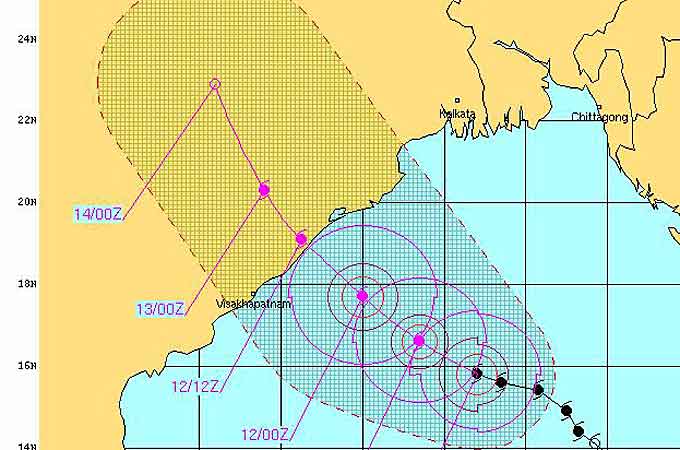Cyclone Phailin hits India’s east coast
Huge storm makes landfall as residents flee for shelter and gale force winds are expected to cause heavy damage.

Cyclone Phailiin has made landfall on the east coast of India, an official said, with winds of up to 200km an hour forcing almost 450,000 people to flee and threatening to devastate farmland and fishing hamlets.
Phailin, which gathered speed on Saturday, has the potential to be the strongest storm to hit the area in 14 years.
Keep reading
list of 4 itemsAre seed-sowing drones the answer to global deforestation?
Rainfall set to help crews battling wildfire near Canada’s Fort McMurray
The Alabama town living and dying in the shadow of chemical plants
The US Navy’s Joint Typhoon Warning Center in Hawaii forecast maximum sustained winds of 269kph with gusts up to 315kph.
Satellite images showed the cyclone filling nearly the entire Bay of Bengal, an area larger than France.
“There are some discrepancies in terms of the forecast. The Indian forecasts are slightly different from the Joint Typhoon Warning Center, but nevertheless, no matter how you look at it, it is going to be a truly deadly storm,” Richard Angwin, Al Jazeera’s weather presenter, said.
Officials cancelled holy day celebrations and stockpiled emergency supplies in coastal Odisha and Andhra Pradesh states.
Villages evacuated
In Bhubaneshwar, capital of Odisha, government workers and volunteers were putting together hundreds of thousands of food packages to be distributed at relief camps.
“I request everyone to not panic. Please assist the government. Everyone from the village to the state headquarters have been put on alert,” Naveen Patnaik, Odisha’s chief minister, said.
Authorities have already evacuated 40,000 people from 40 villages to government-run shelters, schools and buildings in five districts of Odisha and there were plans to take 100,000 more to safety, Surya Narayan Patra, Odisha’s disaster management minister, said.
 |
| Satellite images show Cyclone Phailin filling nearly the entire Bay of Bengal before it makes landfall over eastern India |
“No one will be allowed to stay in mud and thatched houses in the coastal areas.”
The government also began evacuating 64,000 people from the low-lying areas of three vulnerable districts in neighbouring Andhra Pradesh state, N Raghuveera Reddy, the state revenue minister, said.
The 1999 cyclone had higher wind speeds and a larger storm surge – six metres – than being currently predicted by the Indian weather office.
Some foreign forecasters have suggested that India’s weather office is underestimating the power of Phailin, which means “sapphire” in Thai.
A government report on the 1999 disaster put the death toll at 8,243 and said 445,000 livestock perished.
Authorities have said they are better prepared this time around.
Cyclones are a common occurrence in the Bay of Bengal at the end of the monsoon season, when sea temperatures are at their warmest.
A cyclone that struck Bangladesh in 1970 killed hundreds of thousands of people.